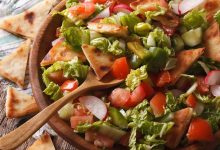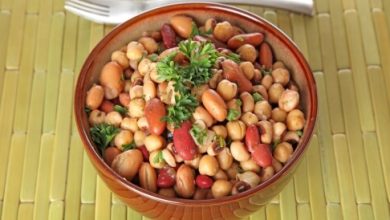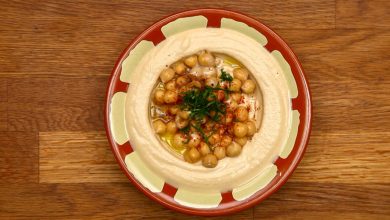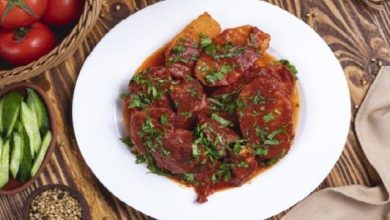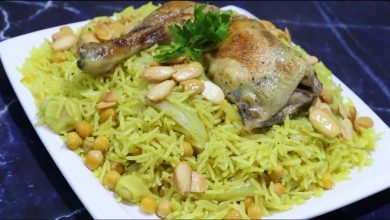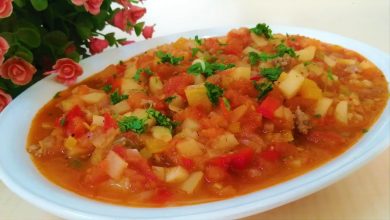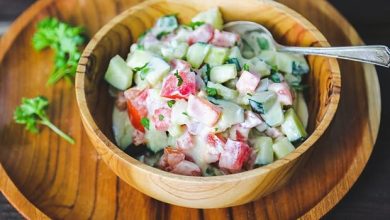Introduction
Mujadara is a simple, yet flavorful Middle Eastern dish that has been enjoyed for centuries. It is made primarily from lentils, rice, and caramelized onions. This vegetarian and vegan-friendly dish is hearty, nutritious, and offers a comforting blend of textures and flavors. Traditionally, it is considered a peasant dish due to its affordability and accessibility, but it has gained widespread popularity around the world for its rich taste and wholesome ingredients.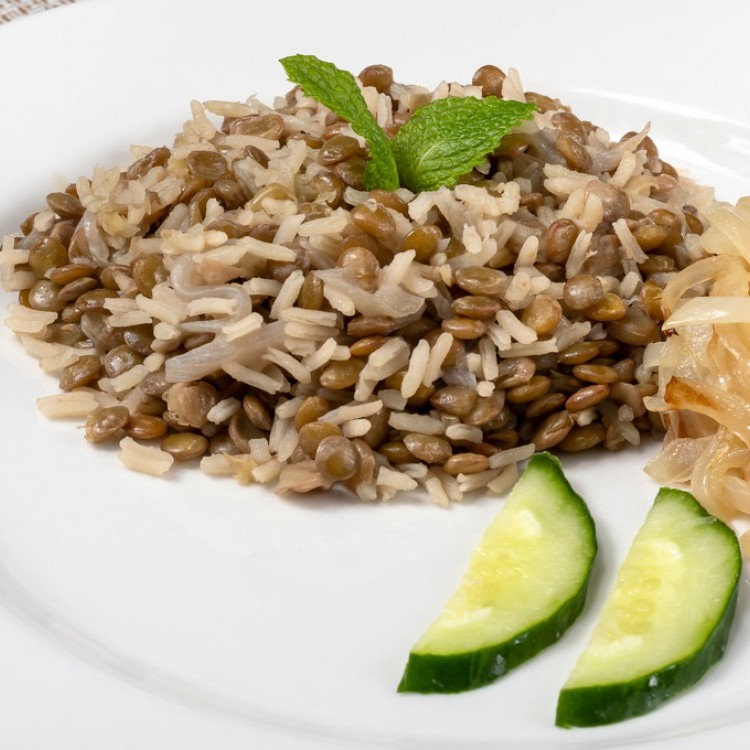
This article delves into the detailed preparation process, the nutritional benefits of Mujadara, and variations of this classic dish. It is broken down into ingredients, step-by-step instructions, and nutritional information, all neatly arranged in tables for clarity.
Ingredients
Mujadara’s ingredients are minimal, but their combination creates a perfect harmony of flavors. Here’s a list of the basic components you’ll need to make the perfect Mujadara:
Basic Ingredients Table
| Ingredient | Quantity | Notes |
|---|---|---|
| Brown or green lentils | 1 cup | Rinse well, can be soaked for quicker cooking |
| Long grain rice | 1 cup | Basmati or jasmine rice can be used |
| Yellow onions | 3 large | Thinly sliced for caramelizing |
| Olive oil | 1/4 cup | Can be substituted with vegetable oil |
| Ground cumin | 1 tsp | Adds an earthy, warm flavor |
| Ground coriander | 1 tsp | Optional for additional flavor complexity |
| Salt | To taste | Adjust to your preference |
| Black pepper | 1/2 tsp | Freshly ground for best flavor |
| Water or vegetable broth | 3 cups | Vegetable broth adds more depth in flavor |
Optional Garnish Ingredients
| Ingredient | Quantity | Notes |
|---|---|---|
| Fresh parsley | 1/4 cup | Chopped finely for garnish |
| Lemon wedges | 4 pieces | For serving, adds brightness |
| Yogurt (plain) | 1/2 cup | For a side dip, use if not vegan |
| Sumac | 1 tsp | Sprinkled for a tangy finish |
| Pine nuts or almonds | 1/4 cup | Toasted, for added texture and richness |
Step-by-Step Instructions
Preparation (10 minutes)
- Rinse the lentils and rice: Start by rinsing the lentils and rice thoroughly under cold water. This helps remove excess starch and ensures a fluffier texture for the rice.
- Slice the onions: Peel the onions and slice them thinly. The key to great Mujadara is in the caramelized onions, so take your time to slice them evenly.
Cooking (45-60 minutes)
Step 1: Caramelizing the Onions
- Heat olive oil: In a large skillet or frying pan, heat the olive oil over medium heat.
- Add onions: Add the sliced onions and cook for 15-20 minutes, stirring occasionally until they turn golden brown and caramelized. Be patient—this step is crucial for developing deep flavors.
- Set aside: Once the onions are caramelized, remove half of them and set them aside for garnish. Leave the remaining onions in the pan.
Step 2: Cooking the Lentils and Rice
- Add the lentils: Add the rinsed lentils to the pan with the remaining caramelized onions. Stir them together and cook for about 2-3 minutes.
- Add water or broth: Pour 3 cups of water or vegetable broth into the pan. Bring it to a boil, then reduce the heat to medium-low and let it simmer for 15 minutes.
- Add the rice: After the lentils have partially cooked, add the rinsed rice to the pan. Stir in the cumin, coriander (optional), salt, and pepper.
- Simmer: Cover the pan and simmer on low heat for another 20-25 minutes, or until the rice and lentils are tender and have absorbed the liquid. You can check if more water is needed during cooking.
Step 3: Final Touches
- Fluff the rice and lentils: Once the cooking time is done, use a fork to gently fluff the rice and lentils.
- Serve: Serve the Mujadara on a large platter. Top it with the reserved caramelized onions and garnish with chopped parsley or other optional toppings like toasted nuts or a sprinkle of sumac for added tang.
Nutritional Information
Mujadara is not only delicious but also highly nutritious. Lentils are an excellent source of plant-based protein and fiber, while rice provides essential carbohydrates. The combination of these ingredients makes Mujadara a filling and well-balanced meal.
Nutritional Table (Per Serving)
| Nutrient | Amount (Per Serving) | % Daily Value* |
|---|---|---|
| Calories | 350 kcal | 17.5% |
| Total Fat | 10 g | 15% |
| Saturated Fat | 1.5 g | 7.5% |
| Cholesterol | 0 mg | 0% |
| Sodium | 350 mg | 15% |
| Total Carbohydrates | 55 g | 18% |
| Dietary Fiber | 12 g | 48% |
| Sugars | 4 g | — |
| Protein | 12 g | 24% |
| Vitamin A | 0% | — |
| Vitamin C | 15% | — |
| Calcium | 5% | — |
| Iron | 25% | — |
Variations of Mujadara
Mujadara can be prepared in a variety of ways, with different regions and families adding their own personal touch. Here are some popular variations you may want to try:
Mujadara with Bulgur
Instead of rice, substitute bulgur wheat for a nuttier flavor and added fiber. This version is quicker to prepare as bulgur takes less time to cook than rice.
Mujadara with Red Lentils
For a creamier texture, red lentils can be used instead of brown or green lentils. Keep in mind that red lentils cook faster and tend to break down more, resulting in a softer dish.
Spicy Mujadara
To give the dish a little kick, add some crushed red pepper flakes or a chopped chili pepper when sautéing the onions. This adds a spicy element to balance out the earthiness of the lentils and rice.
Mujadara with a Side of Yogurt
Although Mujadara is vegan on its own, it can be served with a side of plain yogurt for added creaminess and a cooling effect, especially if you’ve made the spicy version. This is common in many Middle Eastern households.
Storage and Leftovers
Mujadara keeps well and can be enjoyed for several days after cooking. In fact, some people argue that it tastes even better the next day as the flavors have more time to meld.
Storage Guidelines
| Storage Method | Timeframe | Notes |
|---|---|---|
| Refrigerator | 4-5 days | Store in an airtight container |
| Freezer | 2-3 months | Freeze in portions for easy reheating |
Reheating Instructions
To reheat Mujadara, you can use either a microwave or stovetop:
- Microwave: Place a portion in a microwave-safe dish, sprinkle a little water, cover, and heat for 2-3 minutes.
- Stovetop: Heat a portion in a skillet over medium heat with a splash of water to rehydrate the rice and lentils. Stir occasionally to prevent sticking.
Health Benefits of Mujadara
High in Plant-Based Protein
Lentils are one of the most nutrient-dense legumes, rich in protein and fiber. This makes Mujadara a great dish for vegetarians and vegans seeking a wholesome source of protein.
Good Source of Complex Carbohydrates
The rice in Mujadara provides a steady release of energy, thanks to its complex carbohydrates, which digest more slowly than simple carbs.
Rich in Antioxidants
Onions, especially when caramelized, release numerous antioxidants that support immune health and reduce inflammation. These benefits are particularly relevant when paired with lentils and rice, which also contain phytonutrients.
Low in Saturated Fats
Mujadara is a naturally low-fat dish, especially when cooked with olive oil, which is heart-healthy and loaded with monounsaturated fats that promote good cholesterol levels.
Conclusion
Mujadara is a dish that transcends its humble origins to become a beloved meal across various cultures. With its simple ingredients and nourishing qualities, it’s easy to see why this recipe has stood the test of time. Whether you’re a fan of hearty comfort food or looking for a nutritious vegan dish to add to your meal rotation, Mujadara is a versatile option that can be easily modified to suit your tastes.
Its affordability, health benefits, and rich flavors make it a must-try for anyone interested in exploring Middle Eastern cuisine. Try it with the variations suggested or stick to the classic recipe—either way, you’re sure to enjoy this timeless dish.
Frequently Asked Questions (FAQs)
1. Can I use different types of lentils for Mujadara?
Yes, you can use red, brown, or green lentils, but keep in mind that red lentils cook faster and result in a creamier texture.
2. Is Mujadara gluten-free?
Yes, Mujadara is naturally gluten-free if you use rice. However, ensure that your broth (if using store-bought) is certified gluten-free.
3. How can I make Mujadara more flavorful?
For added flavor, try using vegetable broth instead of water and increase the amount of caramelized onions. Adding fresh herbs like parsley or cilantro can also enhance the taste.
4. What can I serve with Mujadara?
Mujadara pairs well with fresh salads, a side of plain yogurt, or a simple cucumber and tomato salad dressed with lemon juice and olive oil.
Enjoy your culinary journey with Mujadara!




